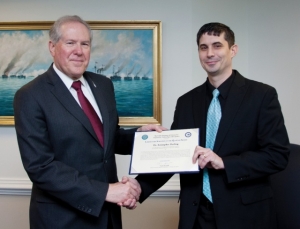Scientist earns distinction through complex research
By Steve Herring
Published in News on March 28, 2017 9:39 AM

Submitted photo
Frank Kendall III, former Under Secretary of Defense for Acquisition, Technology and Logistics presentst Kristopher Darling with the Scientist of the Quarter in December
Kristopher Darling was working in a dentist office pursuing his dream of becoming a dentist.
But while there he discovered a love of working with materials -- a discovery that set him on course to eventually becoming a materials scientist at the Army Research Laboratory, Aberdeen Proving Ground, Maryland.
In December, Darling, 38, was honored by the Department of Defense as its Scientist of the Quarter as part of Lightweight and Specialty Metal Branch.
Darling attended Wayne Community College and became a dental assistant. He worked in a couple of dental offices, the main one being Stovall Family Dentistry office.
Stovall is very supportive and encouraging, he said.
"I wanted to be a dentist at first, but being introduced to all of the materials used in a dental office got me interesting in developing materials," he said.
Darling said he knew he was going to get married so he decided we wanted more education.
"I decided to go to N.C. State for material science and engineering because of the exposure that I had in the dental world," he said.
He graduated in 2005, and after receiving his doctorate degree he went to the Army Research Lab and did a post-doctorate there for a year and a half.
Afterward, he became a staff scientist and has been at the laboratory ever since.
"My thesis work was on developing stabilized nano structure bulk metals," Darling said. "I continued that research up there at the Army working on developing stabilized bulk nanocrytal metals for a variety of applications both protection and lethality applications. There are applications outside of those sort of things."
Metals have a cellular structure just like plants and animals have cellular structures, he said.
They are made up of little individual crystals which look like cells basically, and in normal conventional metals the cells can be centimeters or millimeters in diameter, Darling said.
"We are working on things that are in the nanometer (one-billionth of a meter) range," he said. "You can think of it as a human hair is about a hundred microns in diameter.
"We are looking at things that are about a thousand to 10,000 times smaller than that. We start off with things that are on the order of 30 atoms wide -- the cellular structure is about 30 atoms wide up to a few hundred atoms wide."
At that size there is a deviation from the norm, he said.
"You see a rise in peculiar strength properties or just behaviors in the metal," Darling said. "So for instance, you can make something like aluminum as strong as steel.
"Copper is normally a very weak conductive material. But we can make it as strong as high-strength steel, would almost have the same electrical conductivity. So that is initially where this work took off in replacing a toxic material called copper beryllium."
Beryllium is known for causing a serious lung disease that is basically an incurable cancer of the lungs, he said.
The work to replace copper beryllium could lead into other sorts of applications, he said.
His team's findings were published on Sept. 14, 2016, in the scientific journal Nature. The journal is widely recognized as one of the top two most prestigious academic journals publishing original research across a wide range of scientific fields.
The article outlined how Darling and his team stabilized a copper alloy microstructure and found it to be strong at very high temperature.
The paper focused on how a material behaves in such a way that it opens realms for generating new materials for turbine engine technology that could revolutionize how engines work, he said.
"The Nature paper is sort of on par with an Oscar, Grammy or something like that in the research community," Darling said. "You can go to a lot of the major universities, and you will find a lot of professors who have 30-year careers who may not actually have a Nature or a Science paper. It is very difficult to get even if you are considered in the top five percent.
"That in itself was a pretty big award, just getting the paper. Then I was able to go down to the Pentagon and give a talk down there to some people. It was really interesting."
Darling is the son of Earl and Shirley Darling who moved to Goldsboro when he was 5 or 6.
He attended Grantham Middle School and graduated from Southern Wayne High School in 1996.
Darling and his wife, Gina, have two children, Ava, 12, and Graham, 5.
